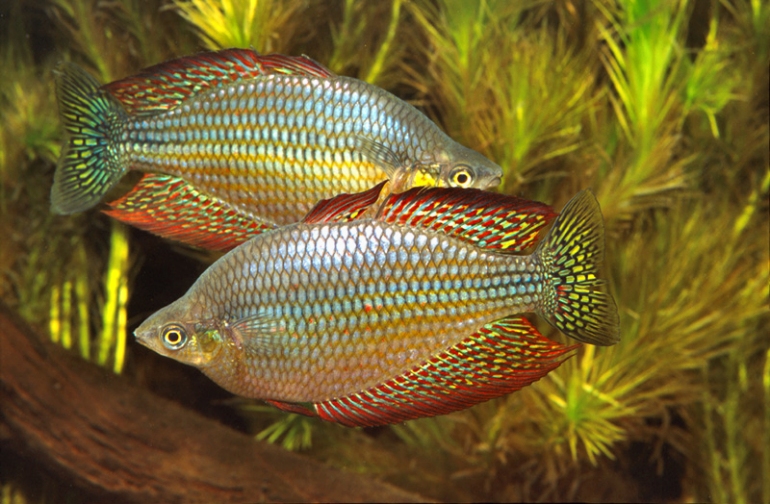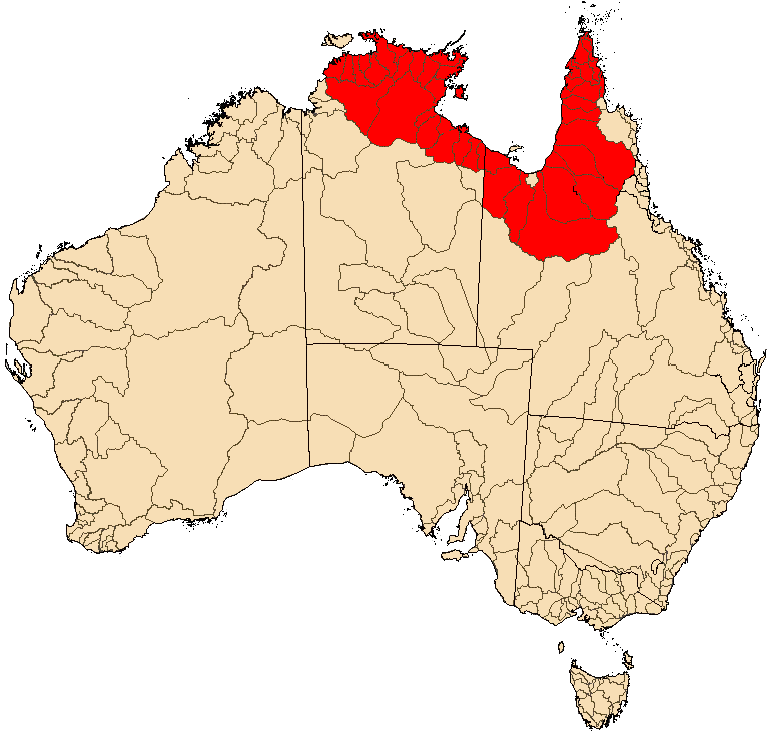|
 |
Melanotaenia inornata [Flat Rock Creek] - photo© Gunther Schmida |
(Castelnau, 1875)
Chequered Rainbowfish
Species Summary
Melanotaenia splendida subsp. inornata were first described in 1875 as Aida inornata. During the 1950-60's they were very popular with native fish keepers in Australia. They were then scientifically known as Aidapora carteri and commonly known as "Carter's Sunfish". They did not become known in the international hobby until around the mid seventies when they were displayed at the Berlin Aquarium. At that point of time they were known as Melanotaenia maculata (Allen, 1978). Gerald Allen's revision of the family Melanotaeniidae in 1980 places them under their current name.
The different subspecies of Melanotaenia splendida are not easily identified in relation to each other as they display a great variation of colours and markings. Principal visual differences are body depth and colour pattern, which is variable depending on location and natural environment. At the same time, body form within each subspecies is variably and appears to be related to habitat conditions, which can sometimes make correct identification difficult. Males and females usually have different colours and this adds further difficulties to species recognition.
Colour variability in rainbowfishes has been a source of confusion to both aquarists and taxonomists studying their life history. Populations of almost every river system they occupy have their own distinctive body colour and pattern. Colour also appears to vary from population to population as well as within a population, particularly during different stages of the fishes' life. This colour variability is related to age, sex, stress, habitat conditions and spawning.
Geographic distribution is very helpful; if you know where they were collected you can generally make a confident identification. Consequently, specific names usually based on the locality where each is found are used by rainbowfish enthusiasts to identify each variety. Where populations need to be identified, they are often done by inclusion of a form or population identifier in brackets following the species name e.g. Melanotaenia splendida subsp. inornata (Flying Fox Creek, Roper River).
Whether or not M. splendida inornata are truly a distinct subspecies is a matter of on-going debate. Ever since Carolus Linnaeus founded the modern system of classifying species in the mid-l8th century, taxonomists have argued over just what exactly species and subspecies are. In general, fishes evolve into different species and subspecies after becoming geographically isolated from others, adapting to their different environments, and changing over time through the process of natural selection. Geographic populations of Melanotaenia splendida have been isolated from each other for perhaps thousands of years. They have gradually evolved physical adaptations that reflect their habitat. Some biologists classify Melanotaenia splendida subsp. inornata as a separate subspecies because they are visibly different. Others say they are genetically the same as other Melanotaenia splendida subspecies and differ only because of environmental circumstances.
Generally the body colour is olivaceous to yellowish with white breast. Scales on side of body with purplish sheen. Mid-lateral stripe deep yellowish anteriorly, and bluish-green or brownish-green on caudal peduncle. Other body stripes yellow or red. An orange or yellow spot on opercula. Dorsal, caudal and anal fins red and yellow chequered or orange-yellow with bright red spots on their membranes, with faint black edge.
 |
Distribution Map |
Distribution & Habitat
M. splendida inornata inhabit the river systems of the Northern Territory and Queensland, which flow into the Arafura Sea and Gulf of Carpentaria - from Darwin to Cape York Peninsula, extending down the east coast to around the Lockhart and Stewart Rivers. The Finniss River is the furthest west that M. splendida inornata has been recorded. They are frequently found in company with other rainbowfish species.
M. splendida inornata are tropical fish and are found in almost every kind of freshwater habitat, from slow-moving streams, wetland swamps, lagoons and clear flowing rivers. They are generally found in waters with moderately thick vegetation. Rainbowfishes have often been reported as being reasonable tolerance to saline waters. However, there are, in fact, few recorded observations of Melanotaenia species in saline waters.
A temperature range of 10~40° Celsius; pH 4.6~8.5 and conductivity 2~220 µS/cm, has been recorded in their natural environment. This wide range of water conditions matches the wide distribution of the species. However, survival rates for M. splendida inornata declines sharply when the water temperature is high and will often die at temperatures above 36°C. Such increases in temperature are common in tropical waterbodies of Australia during the late dry season.
 GS.jpg) |
Melanotaenia inornata [Anniversary Creek] - photo© Gunther Schmida |
Biology & Ecology
M. splendida inornata may reach a maximum size of 12 cm, but usually less than 9 cm, with a body depth of 6-8 cm. Males are more brightly coloured, larger, and much deeper bodied than females. Generally, the larger males can usually be identified from the elongation of posterior rays in the second dorsal and anal fins. Females and juveniles have plain silvery bodies and fins that are either translucent or only faintly coloured compared to the brighter colours of males.
The main components of their diet are algae, aquatic insects, terrestrial insects and microcrustaceans. The algal component consists mainly of green filamentous species. A variety of aquatic insects are eaten; the main identifiable species being chironomid larvae and pupae, and coleopterans. The main terrestrial insects were formicids (ants) and the main microcrustaceans were cladocerans. Traces of hydrophytes, oligochaetes, gastropods, arachnids, macrocrustaceans, teleosts, terrestrial plants, detritus and inorganic material were also found in the stomachs. In the pools and riffles that enter the floodplain in the wet season they feed mainly on non-aquatic insect forms such as winged diptera and ants. M. splendida inornata can therefore be classified as a meiophagous omnivore feeding opportunistically throughout the waterbodies.
M. splendida inornata are reported to migrate upstream at the onset of the breeding season, which corresponds to the start of water flow after the dry season. They spawn for an extended period during the early-wet season, and their gonads are developing for the next year's spawning by the late-wet-early-dry season. In a number of gonads examined, the number of eggs ranged from 70 to 370. Juveniles are found throughout the year, which may suggest that this species spawns throughout the year. However, although juveniles are present throughout the year, this species mainly spawns at the onset of the wet season. They appear to breed throughout the river system and lay a small number of relatively large eggs at a time; these are attached to aquatic vegetation by fine threads from the egg membrane.
Under aquarium conditions, pre-spawning behaviour usually occurs in the morning and may continue for up to an hour before spawning takes place. During this period the colours in both sexes become more intense, but to a lesser extent in the female. In males, the edges of the fins and the chequering of the caudal and second dorsal fins become black. The nape may darken to black in some but not all fish. The midlateral stripe is prominent, extending from the origin of the pectoral fin to the caudal peduncle. Near the tail, two shorter dark lines appear above and below the midlateral stripe. The normal orange-yellow longitudinal stripes become a more intense colour in both sexes. The males have an iridescent purple sheen in light. The operculum has a glowing red spot in both sexes. The pectorals do not become coloured in either males or females. In the females, the midlateral stripe darkens before spawning but the stripe is not as long as in males. The chequered appearance of the second dorsal fin becomes more noticeable and the colour of all the fins darkens except in the case of the pectorals.
Chasing follows immediately after the colour change. The males chase the females, swim below them and brush their vent area with erect dorsal fins or butt them in the vent region or in the area of the pectoral fins. The males frequently tremble as they swim below the females. They display erected fins as they swim beside or at right angles in front of the females. During the pre-spawning chasing and display, the males can become quite aggressive and nip the females if the latter do not show interest in the display. In the final phase of pre-spawning behaviour, the pair swim with their bodies parallel, sinking and rising and then remain in one place with heads touching and their bodies vibrating rapidly. Eggs and sperm are then expelled amongst the plants or spawning medium. Survival of eggs is often reduced by predation activity of the parents during and after spawning.
 GS.jpg) |
Melanotaenia inornata [Habgood River] - photo© Gunther Schmida |
Remarks
Epizootic Ulcerative Syndrome or 'red spot' disease has been identified in M. splendida inornata from a number of river systems in the Northern Territory. This condition is frequently fatal to juvenile fish.
Literature
Allen G.R. (1978) Chasing Rainbows. Tropical Fish Hobbyist, 26 (April): 89-98.
Allen G.R. (1978) The Rainbowfishes of northwestern Australia. (Family Melanotaeniidae). Tropical Fish Hobbyist 26 (April): 91-102.
Allen G.R. (1980) A Generic Classification of the Rainbowfishes (Family Melanotaeniidae). Records of the Western Australian Museum 8 (3): 449-490.
Allen G.R., S.H. Midgley and M. Allen (2002) Freshwater Fishes of Australia. Western Australian Museum.
Beumer J.P. (1979) Reproductive cycles of two Australian freshwater fishes, the spangled perch, Therapon unicolor Gunther, 1895 and the east Queensland rainbowfish Nematocentris splendida Peters 1866. Journal of Fish Biology 15: 111-34.
Bishop K.A., S.A. Allen, D.A. Pollard and M.G. Cook (2001) Ecological studies on the freshwater fishes of the Alligator Rivers Region, Northern Territory; Autecology. Supervising Scientist Report 145, Supervising Scientists, Darwin.
Castelnau F.L. (1875) Researches on the fishes of Australia. Philadelphia Centennial Expedition of 1876. Intercolonial Exhibition Essays, 1875-6. Researches on the fishes of Australia No. 2: 1-52.
Crowley L.E.L.M. & W. Ivantsoff (l982) Reproduction and early stages of development in two species of Australian rainbowfishes Melanotaenia nigrans (Richardson) and Melanotaenia splendida inornata (Castelnau). Australian Zoology 21(1):85-95.
Ivantsoff W., L.E.L.M. Crowley, E. Howe and G. Semple (1988) Biology and early development of eight fish species from the Alligator Rivers Region. Technical memorandum 22, Supervising Scientist for the Alligator Rivers Region, AGPS, Canberra.
Pearce M. (1990) Red Spot. Fishnote. 1/5/1990. NT Department of Primary Industries and Fisheries.
Skidmore J.F.& I.C. Firth (1983) Prediction of the toxicity of heavy metals to Australian aquatic animals. Paper 63 in Environmental Protection in the Alligator Rivers Region. A scientific workshop held at Jabiru, NT, 17-20 May. Supervising Scientist for the Alligator Rivers Region.
Adrian R. Tappin
Updated May, 2013



|

